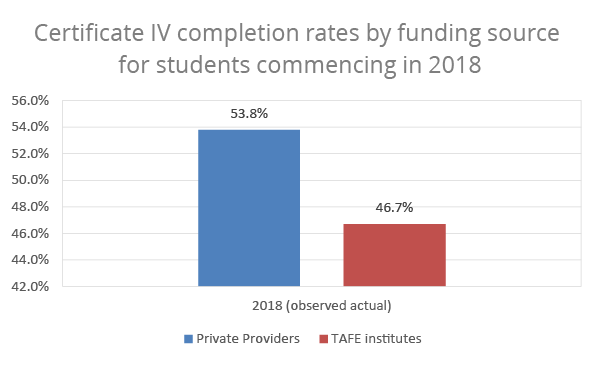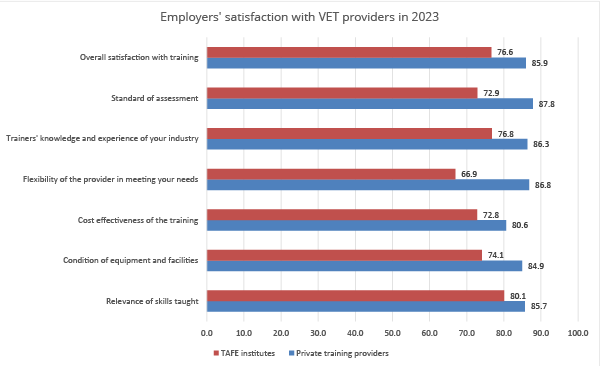Public vs. Private RTOs: Weighing Up Your TAE Options
The education landscape in Australia boasts a vast array of Registered Training Organisations (RTOs) offering diverse courses, making it challenging to choose the right one. RTOs typically fall into two categories: public (such as TAFE Institutes) and private (such as Plenty Training), each with distinct advantages and limitations that cater to different student needs.
The first major difference between the two comes in the form of the number of courses on offer. TAFE institutes tend to have a broad range of possible courses, leaving students with many study pathways all under the same provider. But could these extensive offerings pose challenges in swiftly adapting to industry updates? Typically we see that private RTOs specialise in specific VET fields, offering a more focused set of courses. This specialisation enables them to stay abreast of rapidly evolving industry changes, ensuring faster adaptation to compliance and regulations. Within the RTO landscape, all providers (with the exception of those exclusively operating in Victoria and Western Australia) are regulated by the Australian Skills Quality Authority (ASQA). ASQA sets the standards for RTO’s and can often make sudden changes in compliance regulations or qualifications that all providers must adhere to. Specialised providers tend to have an easier job making these changes quickly, resulting in their students receiving the most up-to-date qualifications.
Another thing to keep in mind when choosing a provider, is how much you’ve decided to invest in your future. Public RTOs are government-funded which may translate to lower enrolment fees by way of funding options which may or may not be available to everyone depending on completion of previous qualifications and personal circumstances. This reliance on government can often mean unforeseen changes to fee structure and student funding support, often leaving students feeling as though they’re victim of a ‘rug-pull’. Also, if you are not eligible for funding at a public RTO, often their full fees can be much higher than those being charged by the private RTOs. Whilst many private RTO’s lack direct government contribution, this absence of involvement means fee structure tends to stay more consistent within each RTO as they need to remain competitive. Some private RTOs may also be able to offer funding which they have secured through government initiatives.
Completion rates are another area to consider. When looking at data obtained from the National Centre for Vocational Education Research (NCVER), we can see that for students commencing qualifications in 2018, qualification completion rates were more than 7% higher for private RTO’s (53.8.2%) compared to their public counterparts (46.7%). Also, with so much ‘free’ public training available, it might be expected that completion rates in public RTOs may dip even lower if students do not need to contribute any money towards their courses, and therefore may place less value on completing the training overall.

Data captured from NCVER, ‘VET qualification completion rates 2022: data slicer’
Another key factor to keep in mind when deciding which option is best for you, is overall student experience. According to NCVER data, while public institutions still maintain a relatively high satisfaction rate, private providers notably excel in most key metrics. For instance, private RTOs exhibit a 9.3% higher overall satisfaction rate (85.9%) than public institutions (76.6%).

Data captured from NCVER, ‘Employers’ use and views of the VET system 2023: data tables‘
The choice between public and private Registered Training Organisations (RTOs) in Australia is a multifaceted decision that hinges on various factors. TAFE Institutes, offer a wide array of courses under one umbrella but may face challenges in swiftly adapting to industry changes, whilst private RTOs, specialising in specific fields, excel in keeping pace with industry updates due to their focused approach. The funding structure differs significantly, with government-backed public RTOs generally featuring lower enrollment fees subject to potential fluctuations, whilst private RTOs maintain more consistent fee structures with greater flexibility. Higher fees in private institutions often translate to investments in experienced trainers and superior resources, correlating with higher qualification completion rates. Furthermore, while both options maintain satisfactory student experiences, private RTOs often surpass public institutions in overall satisfaction rates.
If you are still unsure about which option may be right for you, Plenty Training’s dedicated team of course advisors are waiting for you to book a time to discuss more about your course options. Click here to book a call now, or call 1800 786 651 to speak to a Course Advisor directly.

